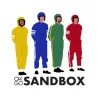
Digital Citizenship Week is October 20–24!
Join teachers worldwide to promote a healthy, positive approach to media and tech.
Take a look inside 5 images
OK Go Sandbox
Pros: Fun music videos are a great hook; kids are motivated to create their own innovations using STEAM skills.
Cons: Lessons are organized on the site by music video, making it hard for teachers to match activities to their specific needs.
Bottom Line: After watching OK Go music videos, kids will be excited to make new creations by integrating art, science, and math.
OK Go Sandbox clusters its materials by music video. Teachers need to keep digging to realize all the site has to offer. The tools work best if teachers take the time to explore each of the connected resources and build a plan that works for their grade level and classroom. For example, "How Parabolas Work" has two lesson plans using the same set of videos. The General Parabolas guide is geared toward middle school students, and the Advanced Parabolas guide is aligned with high school Common Core standards. This might be useful for teachers who are differentiating within one class; the entire class can watch the video, but different groups may engage in different tasks afterward.
Resources that support each other are grouped on the site. In the "Hit the Note" lesson, students are asked to use the Google Science Journal app to tune glass cups and play a song. OK Go Sandbox has paired this with a Science Journal scavenger hunt to help students familiarize themselves with another great free tool.
OK Go Sandbox hooks kids with indie group OK Go's music videos and then follows up with guided inquiry and engineering design challenges. Elementary through high school students get ideas from the videos and use them to make their own creations.
Lessons are linked to physical science, math, and art standards. Kids use parabolas to figure out how the band achieved zero gravity in the "Upside Down & Inside Out" video. The flip books in the "The One Moment" video inspire students to make their own flip books, where art and innovation are emphasized more than any particular content. Each video is paired with lesson plans that include worksheets and directions for hands-on challenges. For example, students are asked to graph the parabolas they find in two differently shaped bowls.
OK Go Sandbox encourages creation and innovation in math, science, and art as students use phenomena to figure out music videos. These inquiry and design challenges provide opportunities for students to engage in the Next Generation Science Standards (NGSS) Science and Engineering Practices.
In the "Chain Reaction Machine" lesson, students build a machine that links multiple simple machines together. They're encouraged to match their chain reaction to the timing of the OK Go song "This Too Shall Pass." It's clear from the videos that the members of the band OK Go -- and their directors -- have a real passion for figuring things out. This makes the behind-the-scenes clips particularly powerful, as they explain the various innovations involved in creating each music video.
In OK Go Sandbox, lessons are driven by the videos and not by specific grade-level standards. As a result, the math, science, and standards from each lesson come from a variety of grades. This makes it difficult for teachers to select lessons that meet their specific classroom context. That being said, the videos make for interesting phenomena, and with a little tweaking, the lessons can be made to fit multiple grade levels.














